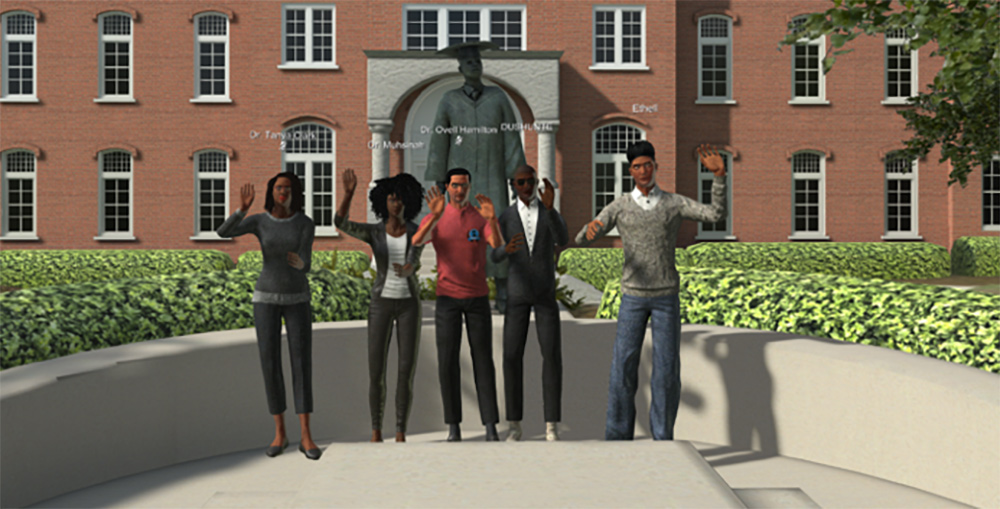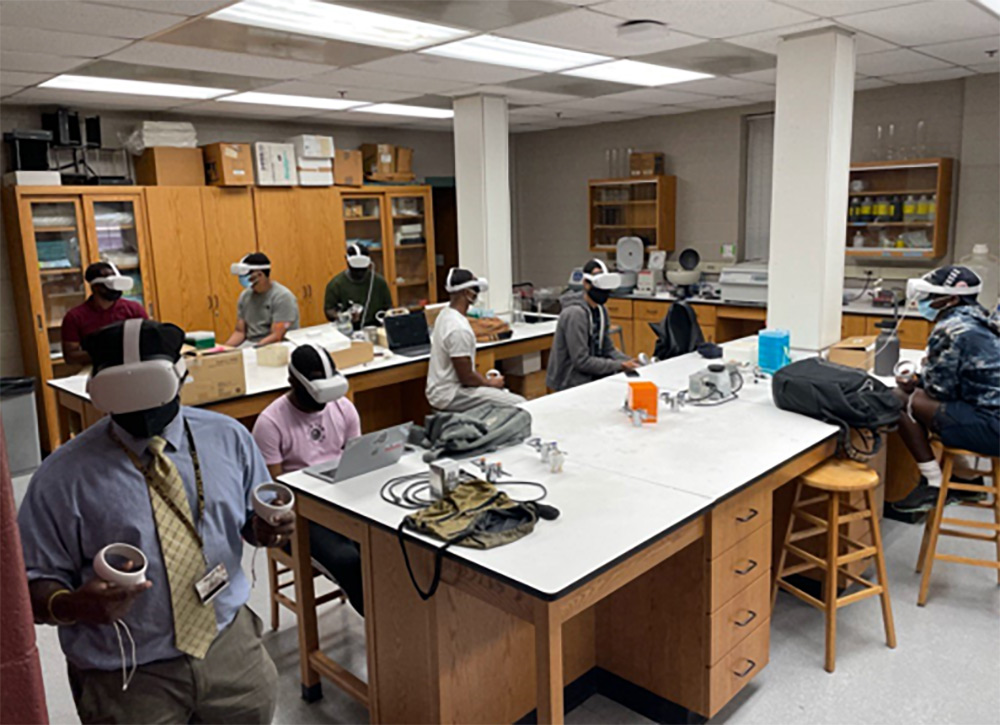of the Classroom:

Using the expertise of experts like Wendy Martin, national runner-up teacher of the year, and others, we built a virtual reality cadaver lab that included the organ systems of a human body. But even more than that, this lab is synchronous, meaning the entire class can come into the room at the same time, and be joined by their professor. Stop and think about this for a minute. These students might be miles apart — they might be hundreds of miles apart — but in that cadaver lab, they stand right next to each other. As the professor teaches, she may take her hand and plunge it into the chest cavity of the human cadaver and pull the heart out (not dripping in blood, like the movies, but anatomically perfect).
The professor will take that heart and hand it to the student next to her, who is inches apart in the lab, but miles apart in the real world. That student will take the heart and study it according to the lesson being taught, then hand it to the student next to him.
The second student will take that heart and expand it until it is six feet across and eight feet tall. The students, along with their professor, will then step inside the heart and examine the ventricles and the cavities. Finally, the professor will produce a diseased heart, expand it to be eight feet tall so that all the students can step in and examine the effects of smoking and a poor diet.
Learning’s Future?
We know this is a megatrend that will continue for years as decentralization takes hold. So, how will we provide these remote learners a learning experience that is better than the brick-and-mortar classroom? Will we put them into a 2D web-based learning environment like Zoom or some other platform?
Experiential learning, which is kinesthetic, is so important that we want to make that available to students no matter where they learn. It may sound obvious, but this means chemistry experiments in chemistry class, global field trips in history class, and animal dissection in biology.
The Metaversities
Once in their class, they see their professor and the other students. These metaversities will — in one fell swoop — revolutionize the future of remote learning, and it all begins in the fall of 2022.

In addition, in the virtual reality classroom, they can hold and manipulate objects. Think about chemistry class; it is impossible to do chemistry experiments in a 2D Zoom atmosphere. But in the experiential kinesthetic classroom of virtual reality, you can do traditional chemistry experiments as if you are standing in an actual classroom.
So Far, So Good
One of the classes taught was World History with Professor Ovell Hamilton. When he taught his classes, instead of having his students read about an experience, he took them to that location and taught it there. For example, the week he taught World War II History, he held the class on a time-accurate battleship floating in the South Pacific. It helps that Professor Hamilton is a United States Navy Officer (retired), so when he takes you on a tour of a battleship, he really knows what he is talking about.
As you may imagine, learning comes alive for students in this way. Professor Hamilton taught that class in a brick-and-mortar classroom, online through Zoom, and finally, he taught it on the Morehouse metaversity campus. He was then able to compare the three. He measured student engagement, student satisfaction, and student performance, and in all three measurements, the metaversity campus was significantly better than the other two.

Location, Location, Location
For American High School, we built the courtroom from the book “To Kill a Mockingbird” as a digital twin. As students read the book and study it, they have a more empathetic understanding of the characters in the book as they sit in different locations in the courtroom. Some may sit in the balcony, some may sit on the floor, some might sit on the judge’s bench or in the jury box. As they change seats, they understand it from the view of the different characters in the book. If you recall from your high school literature, where you sat in the courtroom had cultural and legal significance. This is the value of teaching in an actual literary location from a book that is read widely around the world.
There are many other great places to learn. Think about learning astronomy on a starship and then putting on a space suit and taking a space walk outside. Think about learning the history of Charles Darwin and his theory of evolution, as you board the HMS Beagle and then disembark to his landing place on the Galapagos Islands. Imagine learning paleontology on dinosaur island or art history in an art history museum with the world’s greatest art so well recreated as a digital twin, you can see the brush strokes on the paintings.
The future of virtual reality and augmented reality are bright for both K-12 education and higher education. Virtual reality is perfect for students learning remotely. Students can put on a headset, or they may also join into a 3D world via computer and move around that world similar to the way people playing the game Fortnite or Call of Duty move around those 3D worlds.
Augmented Reality
When students walk outside around campus, they can see flowers that may have been extinct for a million years. Now, they are growing on the campus, and with a simple touch of the flower, it expands until it is five feet tall, and you can see the pistils and the biology of the flower.
All this is possible because of immersive technologies. There are several big players in the hardware for both virtual reality and augmented reality. The biggest player in virtual reality hardware is currently Meta, with their Quest headset. We expect in the next few months to see a pro version of that headset come out. Other big players include HTC Vive, Pico, and Lenovo.
In the augmented reality glasses space, there are three primary players. Lenovo’s A3 glasses are a workable product in the marketplace today, and the Magic Leap 2 is rolling out in the fall of 2022. Another big player is NReal, and of course, Microsoft with its Hololens.
Sure, It’s Cool, But Does It Work?
We cited the study from Morehouse college, which shows that student engagement, student satisfaction and student performance increased when compared to real classrooms and 2D online classrooms. But if you look at the PWC study from the summer of 2021, you can see that student learning increases significantly, and students have a much greater emotional connection to the information they learn.

Future Perfect?
We are in a similar place with metaversities. Immersive learning is coming, and it is coming fast. Synchronous, immersive learning is the more important use case that matters because it allows students to gather together socially and to learn in groups, just as humans have done for thousands of years. Every university in the world that uses some type of remote learning will have a metaversity campus between now and 2030. Crazy today, obvious tomorrow.
This type of growth will transform the way we learn, the way we socialize, and it will transform the geography and the social centers of cities across the United States. It is difficult — sitting here today — to look forward and understand all the effects it will have on society; but one thing we can be sure of is the impact will be dramatic.
We are about to undergo a revolution that really does nothing more than take us back in time. It was not that long ago in human history when students learned kinesthetically and experientially. Blacksmiths, carpenters, doctors, cobblers, and everyone else learned through apprenticeships and hands-on practice. We will quickly see that happen again through immersive technologies. Granted, it will be supplemented with videos, text, audio, AI, and deep research, but hands-on learning is on its way back and learners will be all the happier for this improvement.
About the author